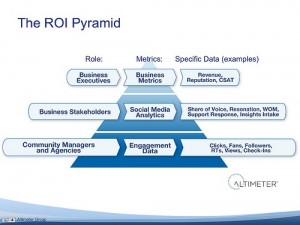 Today, I’ve got my social sales evangelism hat on, because I sometimes forget that not everyone sees the value in using new technology to augment their sales process. Though by now it’s pretty obvious that social media is here to stay, there continues to be debate about whether or not the use of social media can actually have any impact on your sales. Many sales professionals still view the use of social media as either something that “the kids” are using, or they believe that the use of social media has no real role to play in the sales process. Unfortunately, these attitudes cause many folks to completely ignore the opportunity that social technologies offer them. That, in my opinion, is a shame.
Today, I’ve got my social sales evangelism hat on, because I sometimes forget that not everyone sees the value in using new technology to augment their sales process. Though by now it’s pretty obvious that social media is here to stay, there continues to be debate about whether or not the use of social media can actually have any impact on your sales. Many sales professionals still view the use of social media as either something that “the kids” are using, or they believe that the use of social media has no real role to play in the sales process. Unfortunately, these attitudes cause many folks to completely ignore the opportunity that social technologies offer them. That, in my opinion, is a shame.
Let’s do away with the first myth right now…that social media is just a kid’s thing.
As you might expect, this sentiment is most often expressed by the boomer generation who’ve not quite accepted that social goes way beyond their kid’s texting about the concert they attended last night. Yes, the younger set has grown up digital, so it’s more natural for them to use Facebook or Twitter to keep up with their social networks. But as evidenced by the skyrocketing growth of LinkedIn, more than 90 million business professionals are using LinkedIn as a viable medium for networking with potential buyers, referral partners and current customers. In fact, did you know that roughly 70% of those LinkedIn users are decision makers? In other words, these are the people who can buy your products and services. Now, it is true that far too many LinkedIn users aren’t using the technology as effectively as they could be, but that’s a subject for another post.
What about the mistaken belief that social media has no role to play in sales?
After hundreds of conversations with business owners and sales executives, I think one main reason many sales people resist using social technology is because they have unrealistic expectations about what social media can do for them. A LinkedIn profile today doesn’t mean an immediate sale tomorrow. Frankly, that’s just as unrealistic as thinking you’ll meet someone tonight at a networking event and by morning will have a deal. The value of social media is about increased exposure with a wider audience of people who can buy from you. I like to say that just because you have something to sell, it doesn’t mean that your prospect is ready to buy. If you aren’t visible in the social space, it’s not likely that your name will rise to the top of potential vendors when the time comes.
Remember…
Your prospects have far more options than ever before. They also spend a fair amount of time gathering information online. It’s cool if you don’t feel the need to have presence in the social space, but your savvy competitors are no doubt there. Are you sure that’s a risk you are willing to take?



